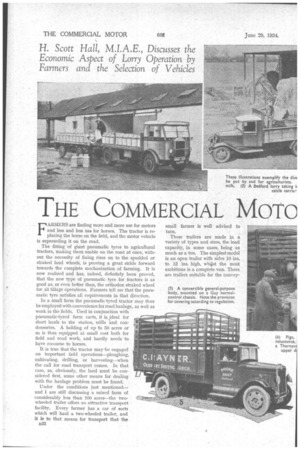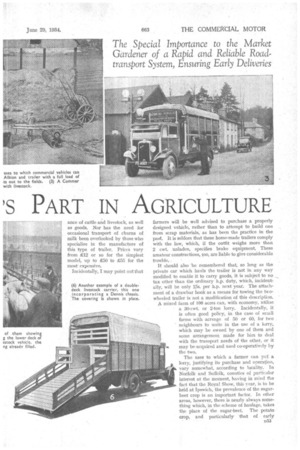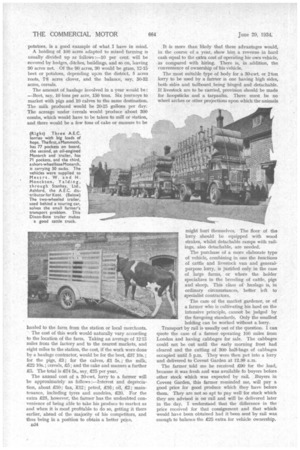THE COMMERCIAL MOTO 'S PART IN AGRICULTURE
Page 86

Page 87

Page 88

If you've noticed an error in this article please click here to report it so we can fix it.
FARMERS are finding more and more use for motors and less and less us a for horses. The tractor is replacing the horse on the field, and the Motor vehicle is superseding it on the road.
The fitting of giant pneumatic tyres to agricultural tractors, making them usable on the road at once, with out the necessity of fixing rims on to the spudded or straked land wheels, is proving a great stride forward towards the complete mechanization of farming. It is now realized and has, indeed, definitely been proved, that the new type of pneumatic tyre for tractors is as good as, or even better than, the orthodox straked wheel for all tillage operations. Farmers tell me that the pneumatic tyre satisfies all requirements in that direction.
In a small farm the pneumatic-tyred tractor may thus be employed with convenience for road haulage, as well as work in the fields. Used in conjunction with pneumatic-tyred farm carts, it is. ideal for short hauls to the station, Mills 'and condensories. A holding of up to 50 acres or so is thus equipped at small cost both for field and road work, and hardly needs to have recourse to horses.
It is true that the tractor may be engaged on important field operations—ploughing, cultivating, drilling, or harvesting—when the call for road transport comes. In that case, as, obviously, the land must be considered first, some other means for dealing with the haulage problem must be found.
Under the conditions just mentioned— and I am still discussing a mixed farm of considerably less than 100 acres—the twowheeled trailer offers an attractive transport facility. Every farmer has a car of sorts which will haul a two-wheeled trailer, and it is to that means for transport that the small farmer is well advised to turn.
These trailers are made in a variety of types and sizes, the load capacity, in some cases, being as much as a ton. The simplest model is an open trailer with sides 10 ins. to 12 ins, high, whist the most ambitious is a complete van. There are trailers suitable for the convey ance of cattle and livestock, as well as goods. Nor has the need for occasional transport of churns of milk been overlooked by those who specialize in the manufacture of this type of trailer. Prices vary from £12 or so for the simplest model, up to £50 to £55 for the most expensive.
Incidentally, I may point out that farmers will be well advised to purchase a properly designed vehicle, rather than to attempt to build one from scrap materials, as has been the practice in the past. It is seldom that these home-made trailers comply with the law, which, if the outfit weighs more than 2 cwt. unladen, specifies brake equipment. These amateur constructions, too, are liable to give considerable trouble..
It should also be remembered that, so long as the private car which hauls the trailer is not in any way modified to enable it to carry goods, it is subject to no tax other than the ordinary h.p. duty, which, incidentally, will be only 15s. per h.p. next year. The attachment of a drawbar hook as a means for towing the tw owheeled trailer is not a modification of this description.
A mixed farm of 100 acres can, with economy, utilize • a 30-cwt. or 2-ton lorry. Incidentally, it is often good policy, in the case of small farms with acreage of 50 or 00, for two neighbours to unite in the use of a lorry, which may be owned by one of them and some arrangement made for him to deal with the transport needs of the other, or it may be-acquired and used co-operatively by the two.
The uses to which a farmer can put a lorry, justifying its purchase and operation, vary somewhat, according to locality. In Norfolk and Suffolk, counties of particalar interest at the moment, having in mind the fact that the Royal ShoW, this year, is to be held at Ipswich, the prevalence of the sugarbeet crop is an important factor. In other areas, however, there is nearly always something which, in the scheme of haulage, takes the place of the sugar-beet. The potato crop, and particularly that of early potatoes, is a good example of what I have in mind.
A holding of 100 acres adapted to mixed farming is usually divided up as follows :-10 per cent. will be covered by hedges, ditches, buildings, and so on, leaving 90 acres net. Of the 90 acres, 30 would be grass, 12-15beet or potatoes, depending upon the district, 5 acres roots, 7-8 acres clover, and the balance, say, 30-32 acres, cereals.
The amount of haulage involved in a year would be: —Beet, say, 10 tons per acre, 150 tons. Six journeys to market with pigs and 10 calves to the same destination. The milk produced would be 20-25 gallons per day. The acreage under cereals would produce about 300 combs, which would have to be taken to mill or station, and there would be a few tons of cake or manure to be hauled to the farm from the station or local merchants.
The cost of this work would naturally vary according to the location of the farm. Taking an average of 1215 miles from the factory and to the nearest markets, and eight miles to the station, the cost, if the work were done by a haulage contractor, would be for the beet, 237 10s.; for the pigs, £3; for the calves, 21 5s. ; the milk, 222 10s.; cereals, £5; and the cake and manure a further 25. The total is 274 5s., say, 275 per year.
The annual cost of a 30-cwt. lorry to a farmer will be approximately as follows :—Interest and depreciation, about 250; tax, £12; petrol, £16; oil, £2; maintenance, including tyres and sundries, 2.20. For the extra 225, however, the farmer has the undoubted convenience of being able to take his produce to market as and when it is most profitable to do so, getting it there earlier, ahead of the majority of his competitors, and thus being in a position to obtain a better price.
D34 It -is more than likely that these advantages would, in the course of a year, show him a revenue in hard cash equal to the extra cost of operating his own vehicle, as compared with hiring. There is, in addition, the convenience of ownership of his vehicle.
The most suitable type of body for a 30-cwt. or 2-ton lorry to be used by a farmer is one having high sides, both sides and tailboard being hinged and detachable. if livestock are to be carried, provision should be made for hoopsticks and a tarpaulin. There must be no wheel arches or other projections upon which the animals
might hurt themselves. The floor of the lorry should be equipped with wood strakes, whilst detachable ramps with railings, also detachable, are needed.
The purchase of a more elaborate type of vehicle, combining in one the functions of cattle and livestock van and generalpurpose lorry, is justified only in the case of large farms, or where the holder specializes in the breeding of cattle, pigs and sheep. This class of haulage is, in ordinary circumstances, better left to specialist contractors.
The case of the market gardener, or of a farmer who is cultivating his land on the intensive principle, cannot be judged by the foregoing standards. Only the smallest holding can be worked without a lorry.
Transport by rail is usually out of the question. I can quote the case of a farmer operating 100 miles from London and having cabbages for sale. The cabbages could not be cut until the early morning frost had cleared and the cutting of 300 half-bags of cabbages occupied until 5 p.m. They were then put into a lorry and delivered to Covent Garden at 12.30 a.m.
The farmer told me he received 290 for the load, because it was fresh and was available to buyers before other stock which was expected by rail. Buyers in Covent Garden, this farmer reminded me, will pay a good price for good produce which they have before them. They are not so apt to pay well for stock which they are advised is on rail and will be delivered later in the day. I understand that the difference in the price received for that consignment and that which would have been obtained had it been sent by rail was enough to balance the 225 extra for vehicle ownership.
































































































































































